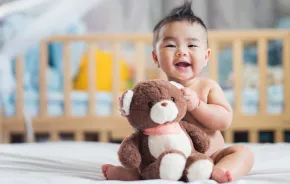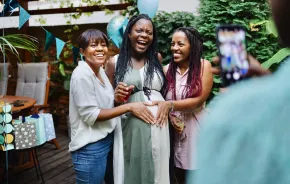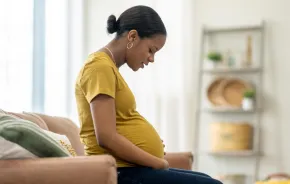 An employee at a baby clothing store once tried to convince me to buy my infant daughter $40 “crib shoes.” The shoes were little black patent leather Mary Janes with hard soles, intended for a 3-month-old child — just to look cute. I resisted the temptation to ask this salesperson if she was crazy, but I couldn’t imagine spending $40 on baby shoes just for cuteness’ sake.
An employee at a baby clothing store once tried to convince me to buy my infant daughter $40 “crib shoes.” The shoes were little black patent leather Mary Janes with hard soles, intended for a 3-month-old child — just to look cute. I resisted the temptation to ask this salesperson if she was crazy, but I couldn’t imagine spending $40 on baby shoes just for cuteness’ sake.
Despite my disdain for the crib shoes, I have succumbed to a load of things that I thought I needed for my children over the years, only to see them collect dust or trip over them as they clutter my house. It’s OK to indulge in something just because it’s adorable now and again. But in this economy, most of us just don’t have the luxury of buying unnecessary things. So, take some advice from experts in the field — parents! — on what they couldn’t live without, and what they wish they had lived without.
Diapers
A hundred years ago, no one used disposable diapers. In fact, some cultures still don’t use diapers at all. Can you imagine washing diapers on the African savannah? It’s just not feasible — and there is no trash service. Like mothers in more rustic environments, you, too, can reject the idea of filling landfills with plastic diaper waste.
Shoreline mom Nadine Martinez has made the decision to use ancient methods of baby rearing by practicing elimination communication (EC). She puts her daughter over a potty when she has to eliminate rather than relying on diapers. “We saved on diapers immediately [when we started EC at 6 weeks of age]. Every elimination in her potty was one less diaper,” says Martinez. “Now that she is 11 months old and able to sign ‘potty’ to us, we go through one diaper during the day, and one at night.”
If you’re not ready to embark upon a diaper-free existence, consider the convenience and environmental benefits of a diaper service. For close to the cost of disposable diapers, you can have a diaper service come to your door to drop off clean diapers and remove soiled ones each week. Using cloth diapers keeps waste out of the landfill, and the soft cotton diapers offered by a diaper service feel luxurious compared to disposables.
And with biodiesel trucks and super-efficient washing systems, a diaper service uses far less energy than space-age disposables, according to Mark Steif, owner of Baby Diaper Service.
By far the most economical option, cloth diapers also can be bought and washed at home, just as your grandmother did. While you are considering cloth diapers, think about using reusable wipes. “Old washcloths work great instead of disposable wipes,” says Fremont mom Leah Eister-Hargrave, who cut down on trash this way with both of her children. “You can get a bunch at secondhand stores for really cheap and just wash them with your diapers or wraps.”
Strollers
Strollers are almost always superfluous with newborn babies, who don’t weigh very much and who really prefer to be held closely. Relying on a stroller means you will be continually hauling it in and out of a car, looking for an almost always out-of-the-way elevator, and folding the contraption up to ride the bus. It’s hard to argue with a stroller as being a convenient option for a toddler, who weighs a lot more and who is more interested in having some independent space.
But a stroller is a totally avoidable expense if you are willing to consider “wearing” your baby in an ergonomically designed baby carrier. When looking for a baby carrier, consider the advice of Gita Vasudeva, D.C., who focuses on prenatal and pediatric chiropractic at Health Excellent Chiropractic in Seattle. She suggests you consider how the carrier fits you as well as how it fits your baby. “Are you going to be comfortable wearing it for several hours at a time? If you are not comfortable, you will have problems,” Dr. Vasudeva notes.
Check out the location of the straps to ensure they are in a comfortable position. Note how the carrier will distribute the weight on your body. For babies, Dr. Vasudeva recommends looking at how the carrier supports your baby’s head as well as her hips. “If it’s a young baby, and her neck will be wobbling off to one side, that’s not good because every time you take a step, it will affect the biomechanics of the neck. And make sure the hips and pelvis are supported.”
Need more reasons to skip the stroller for the first year or two? “For newborns, temperature maintenance, heart rate and breathing regulation all improve when parents carry babies in a baby carrier,” says Dr. Jeff Ernst, a pediatrician at Richmond Pediatrics in Shoreline. And, Dr. Ernst says, wearing a baby also increases bonding with parents and boosts baby’s motor development. “They get more variable body positions than they would in a stroller or car seat,” says Dr. Ernst. “And their vestibular system gets a better experience. This does great things for brain complexity and motor development.”
Cribs
A crib is a big, expensive piece of furniture that frequently goes unused by many families with new babies. Most expectant parents envision their babies sleeping peacefully in a beautiful crib, the crown jewel of an adorable nursery. Lake Forest Park mom Vicki Pettiross says, “I thought I needed a beautiful crib — wrong! My kids hardly ever slept in it, since they preferred sleeping with us in our bed or on a futon on the floor.”
Northgate mom Lisa Sharp agrees: “With my first daughter, we had a crib that ended up being our storage area for all of the baby gear that we never used!” Cribs are a uniquely Western and fairly modern invention. Many, many millions of human babies have lived without them, and yours can as well. Rather than investing hundreds of dollars in a crib and special crib bedding, you can choose to use a co-sleeper, a mattress on the floor, or to sleep with your baby in a safe adult bed.
According to James J. McKenna, director of the Mother-Baby Behavioral Sleep Lab at the University of Notre Dame, the advantages of co-sleeping can include less crying and a sense of security on the part of the baby, less disruption to the sleep of a breastfeeding mother, and a closer attachment between parents and babies. McKenna notes that safe co-sleeping guidelines should be followed every time a parent sleeps with a baby.
There are myriad solutions for creating a safe co-sleeping space, some of which require spending no money at all. Or consider a specially made bumper, which can be used to create a bump to help prevent a baby, or even a toddler, from rolling off the bed.
Swings, saucers, bouncers, walkers and jumpers
You can buy an endless number of contraptions in which to stash your baby, and many come with claims that they help your baby’s brain or body develop. But all you really need to encourage this healthy development is a safe spot on the floor, your own arms and a good baby carrier.
A baby needs supervised playtime on her tummy. According to the National Institutes of Health, tummy time helps babies develop strong muscles and prevents head flattening. Stores sell a multitude of mats for babies to use for tummy time, but you can save your money and provide just as rich an environment with a colorful quilt or soft rug.
Infant toys
If you have ever seen a baby open up a cabinet filled with colorful bowls or stainless steel pots and pans, you have seen a child filled with the pleasure of exploring sounds, sights and textures (and perhaps even tastes). Give him a wooden spoon to bang and he may stay occupied long enough for you to make a phone call. What more could toys possibly offer? Baby toys often collect dust while your baby crawls around the house looking for more practical items to explore — like the doorstop or the rug.
“I found that toys for babies are mostly a waste,” says Margaret Certain, a Wallingford mom. “Generally, my babies were not interested in toys. They wanted to touch everyday objects that they saw me using — things like jars with lids, wooden spoons and plastic food containers.” If you do want to buy toys for your baby, consider purchasing things that will grow with your child, like a set of nontoxic wooden blocks, or a few soft and snuggly items that your baby will cuddle.
Baby videos
The American Academy of Pediatrics (AAP) recommends that children younger than the age of 2 avoid television entirely. Experts say TV, computers and DVDs can get in the way of exploring, playing and interacting with people, which encourages healthy brain development. Don’t waste your money on them, or feel pressured to increase your child’s intelligence with video media.
“Children are born with a genetic blueprint,” says Dr. Danielle Kassow, a researcher at Thrive by Five Washington, “but parents have the greatest influence on how they develop. You can’t make your child smarter. But you can give him optimal experiences to enhance his learning.”
Don’t spend your time and money on videos for your child. Spend your time interacting with him instead. Cost: free. Value: priceless.
Dressy baby clothes
Issaquah’s Stacy Hauser has three words for new parents: “Cotton. Cotton. Cotton!” She encourages new parents not to waste their money on fancy baby clothes. “Babies pee, poop and spit up on everything!” says Hauser. “They aren’t dolls that stay looking perfect all the time.” Think practically about how you dress your baby.
Wallingford mom Molly Phariss found diaper changes easier with gowns and outfits that did not have too many snaps. “Examine the fasteners on nightwear,” Phariss says. “One big zipper from top to bottom is the worst, since brand-new babies hate to be cold, and you don’t want them to wake up too much during a nighttime diaper change.”
Remember that you will be changing your baby’s diaper at least seven times a day, and consider clothes that make the job easier. And skip the dresses while your baby is learning to crawl. They get in the way of the movements that babies need to make to crawl, which are important for their development.
Baby linens
Babies are as easily dried by the bath towels you already use as they would be by special infant towel sets. Elaborate bedding and quilts are also unnecessary expenses. Puffy or loose blankets should be avoided with an infant in any event, because they are associated with an increased risk of suffocation.
The American Academy of Pediatrics recommends that you skip crib bumpers for the same reason. Instead, consider a couple of swaddle blankets so you can wrap your baby up like a little burrito when he needs soothing. “Swaddling helps replicate the feeling of the womb and prevents the startle reflex while babies are sleeping; therefore, babies sleep longer,” says Jennifer McArthur, a certified doula and Happy Baby educator.
Designer bags and lotions
These days, you can pick a designer diaper bag to match your shoes, and it will have little pockets for bottles and wipes. While this might be a fun accessory, check the price. When you recover from the shock, you’ll probably consider skipping that designer bag!
There is no reason that you cannot haul around the diapers, extra clothes and sippy cups in a tote bag or backpack you already own. A thick blanket or towel works as a changing pad. If you still covet the designer bag, check out the secondhand options before you buy a new one.
When thinking about what to stock in your diaper bag, don’t give in to the pressure to buy lotions to keep your baby’s naturally soft, smooth skin soft and smooth. A child with no skin problems is probably not in need of lotion, according to Belko. “If a baby has a good diet, which means enough breast milk and a diet rich in polyunsaturated fats,” says Dr. Amy Belko of Olympia Pediatrics, “his skin will benefit more than it will from a baby lotion, which can be phenomenally expensive.”
If you do use a lotion on your baby, talk to your doctor about which one to choose. According to a study published last year in The Journal of Pediatrics, some baby lotions can be associated with toxic phthalate exposure in babies. Belko recommends something very simple and oily, with no fragrance. She even suggests using shortening (from the kitchen!), which she says is superior to most of the commercially marketed lotions.
Special foods and big high chairs
“The whole idea of baby food baffles me,” says Cynthia Lair, local author of Feeding the Whole Family and nutrition faculty member at Bastyr University. “This thinking that babies need special food is a myth perpetuated by food manufacturers so we will buy their products instead of steaming some apples and mashing them with a fork.”
Rather than getting tiny jars of processed food, Lair says, we are better off serving our babies something fresh from our own plate. And while you are considering your baby’s future meals, don’t worry too much about having the perfect high chair. “We rarely used the large high chair,” says Amy Gilbrough, experienced Greenwood mom, “opting instead for a little chair that strapped to our regular chairs, which we could also take with us when we traveled.”
Queen Anne mom Jenni Pertuset didn’t use a high chair at all with her daughter. “We were glad for the opportunity to have her right there with us at the table,” says Pertuset. “I think having her on our laps helped her to be more directly engaged with mealtime from the beginning.” For feeding your newborn, you may want a good nursing pillow to help position your baby for breastfeeding.
You don’t absolutely need a nursing pillow, says Sarah Huntington, a lactation consultant and certified doula in Olympia. “But support for your baby while you nurse is really important, both for good positioning and for the sake of mom’s back. “If you don’t have a nursing pillow, having a variety of bed or couch pillows can be a great help.”
Frugal and earth-friendly baby products
A host of products claiming to be eco-friendly cost an arm and a leg, but considering the environmental consequences of your parenting choices need not be expensive. When it comes to baby clothes and toys, you may never have to buy anything new. Between thrift and consignment stores, eBay and craigslist, you can handle most of your baby’s needs. With a little creativity, you can coordinate a kids’ clothing and toy swap in your neighborhood or other community group, and find ways to keep recycling your child’s old clothes while collecting new things that will fit as she grows.
Used items for the first year are generally in great shape, because infants outgrow them before they wear them out. While baby items have a second life in your home, you should refer to the Consumer Product Safety Commission’s website for recall notices to confirm that none of your purchases have been recalled.
Thrift stores are often brimming with old books, and don’t forget that there are free books just waiting for you at your local library. Checking out books from the library is a great way to preview them and see what you like before you buy.
With all of these tips, you can save your money for the essentials, which can be hard to find used, such as a safe infant car seat, nutritious foods, preventive health care or a college fund.
Tera Schreiber is the former executive director of Great Starts Birth & Family Education, as well as the mother of three children, who taught her much about what she did not need to buy for their baby days.











